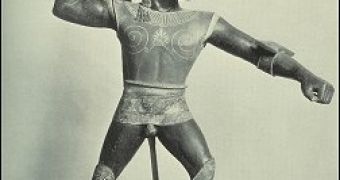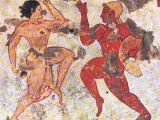The Etruscan civilization flourished on the territory of central Italy (from Po River to Naples) and, besides the Greek one, was the most influential for Romans. The Etruscans appeared, according to the historical annals, around 800-750 BC in Tuscany, the Italian region that was named after the Tuscans (Etruscans). Later they spread into Umbria and Lazio (the region of Rome).
The Tyrrhenian Sea could also have an Etruscan name. Etruscans were not only farmers, but also skilled sailors, who traded with the Greeks and Cartage. The God of the Sea, Neptune, was important in their religion. Fishing was an important activity for the Etruscans, and fish were captured both in the sea and freshwater, using webs, creels and other tools.
The Etruscan life, dances, or other habits, has come to us due to Roman writings and many archaeological discoveries (frescoes, tombs, settlements and others). The Etruscan nation was made of 12 tribes, each tribe being led by its own ruler. The most important Etruscan cities were Caere, Chiusi and Perugia. Each tribe used to have a city center. Etruscans were warriors, farmers, traders, sailors, and craftsmen. War was a common occupation, especially in the years of weak crops.
Women were equal to men, a fact that shocked the "civilized" Greeks and Romans: they did not change their name after marriage, wore elegant clothes, participated in dances and sports. In fact, the woman was the chief of the family (this was a matriarchal society, so different from the other European civilizations) and she chose the husband and educated the children, and that freedom allowed them to have extra-marital affairs. Women of high hierarchy had bronze boxes adorned with inscriptions, so they knew how to read. The tutulus was a braided hairstyle of Etruscan women evolved into conical shaped cap, as worn by peasants and soldiers. Etruscans wore wooden sandals.
Rich people used to keep leopards brought from Africa or Asia caged. Leopards were represented in many tomb wall paintings and the leopard was a prevalent motif in the Etruscan art. Etruscan made gold and bronze jewels, like brooches and figurines with animal or human forms.
The Etruscans mastered a perfected technique of processing bronze and iron. They made bronze helmets whose model was later taken by the Romans. The helmets of the leaders could be ornamented with red tufts. The Etruscan spear and right sword were also used by Romans later. Etruscan soldiers were armored and wore rounded shields; the Etruscan army employed chivalry and war chariots on two wheels, dragged by 2 horses.
Chariots were also employed during sport competitions, especially during spring and fall festivities. Chariot races could also be an act of honor during the burial of an important deceased person (Romans and Greeks enjoyed this sport, too). A short whip was used for driving the horses. Another sport Etruscans enjoyed was wrestling, practiced on arenas, and large amounts of money were bet on it.
The main Etruscan crop was the wheat and the Etruscans employed the ox-driven plow.
The most characteristic Etruscan monuments were the tombs, large chamber dug in the ground, and covered by mounds of soil and stones. The tombs' walls were decorated with vivid wall paintings reproducing scenes of the funerary ceremonies taking place at the death of an important person. The dead person was placed into a sarcophagus and food was left in dishes for the deceased inside the tomb. Flutes were played during the burial ceremonies. Dead warriors were buried with their weapons (including their chariots!). In many cases, the dead persons were incinerated.
Etruscan houses were made of adobe, with roofs made of straws, and were whitewashed. The roof was made on two slopes and the entrance used to have a covered porch.
The Etruscans were highly superstitious and men and women considered their destiny was subordinated to visible signs: birds' flight, the disposition of an animal's bowels, and so on, and thought the future could be forecast, that's why oracles were popular.
The Etruscan mystery is in connection to their unknown origin: where did they come from and what language did they speak? Their language was clearly not Indo-European and knowing more about their language would dissipate their enigma.
Herodotus, the Greek historian of the 5th century BC, said that Etruscans came from Lydia, an ancient kingdom from present-day Turkey. Indeed, tombs found in ancient Lydia are extremely similar to those of the Etruscans.
A DNA analysis revealed that cattle in central Italy seem indeed to have originated in modern Turkey and Middle East. As there is no link between these cattle and others from other European regions, they must have entered the peninsula by sea.
Rome was funded by Etruscans and the legend of its foundation enhances the Lydian theory: they were survivors of the Troy war and Troy was located on the Asia Minor, inside the Lydian territory. But the Lydian theory has a weak point: the Lydian language was Indo-European.
But, in the first century BC, Dionysos of Hallikarnas said the Etruscans came from nowhere, being the natives of Italy, before the invasion of the Indo-Europeans that brought the Latin language into the peninsula. In this case, the theory of their relativeness with the Basque should stand, but the probability that Indigenous pre-Indo-European people could have survived the massive Indo-European invasion for so long and even dominate after is relatively low.
The sailing abilities support the Lydian theory, but also that of the "People of the Sea", seafaring raiders that were at war with the Egyptians in the 12th century BC, whose civilization was centered in Crete (an island in southern Greece) and being people who spoke a non-Indo-European language.
The Crete and Minoan civilization are linked increasingly to the myth of the Atlantis and its decline was caused by a huge ancient tsunami.
Etruscans were good riders and had a well instructed army, hampering the Romans for long, but, in the end, Romans conquered their city-states one by one, between 358-265 BC. These city-states were at war themselves and this helped the Roman conquest. In 87 BC the Etruscans were given the same rights as the Romans and this eased their assimilation.
There are over 10,000 Etruscan inscriptions, most of them short, but, except about 200 words known to be names, their meaning is still not decoded. The Etruscan language is easy to read, as they used the Greek alphabet from the 7th century BC, but it is almost impossible to understand their texts, as it seems no language of its group has survived. A bilingual document like that used by Champollion to decode the Egyptian hieroglyphs would solve the issue.

 14 DAY TRIAL //
14 DAY TRIAL // 
